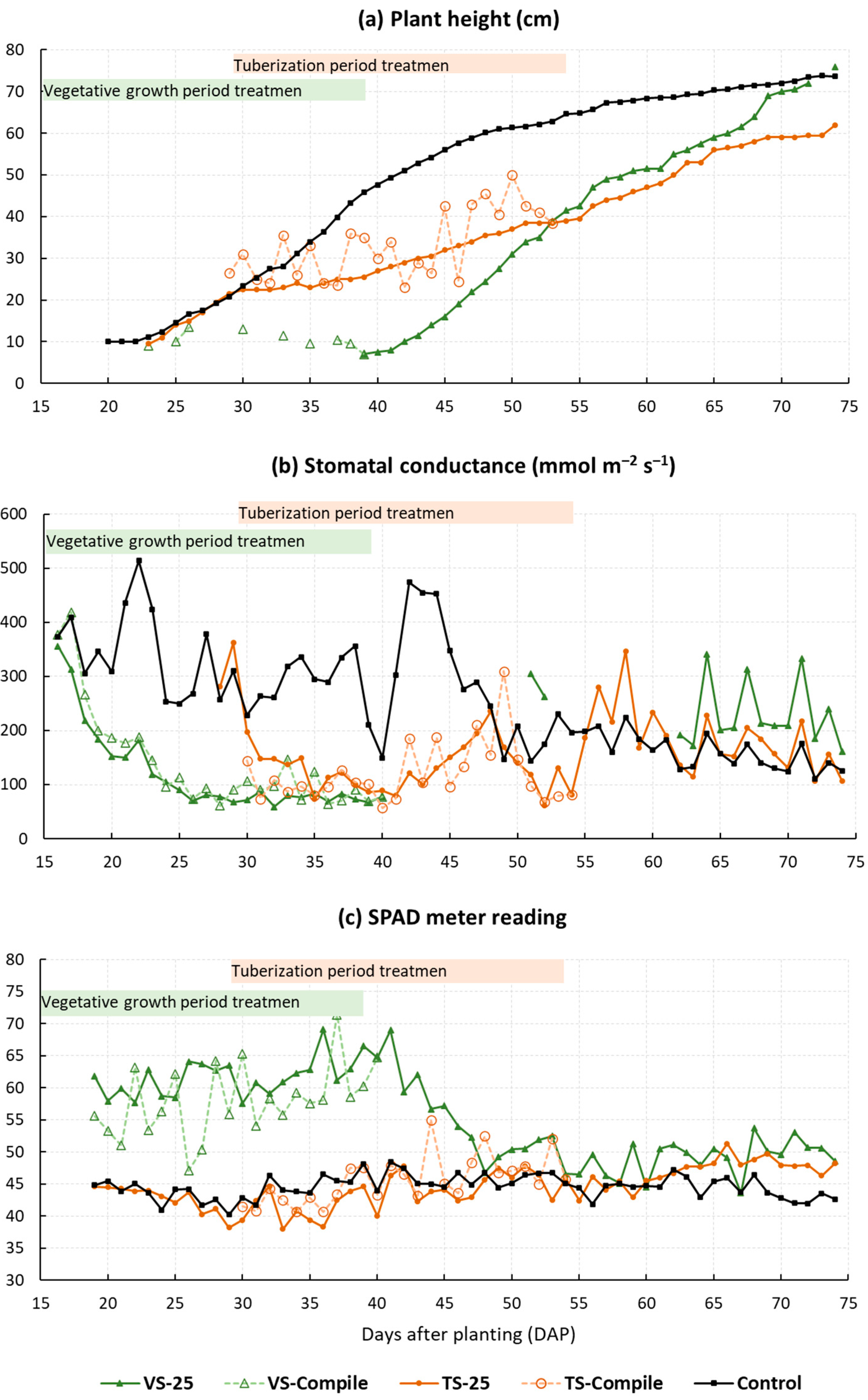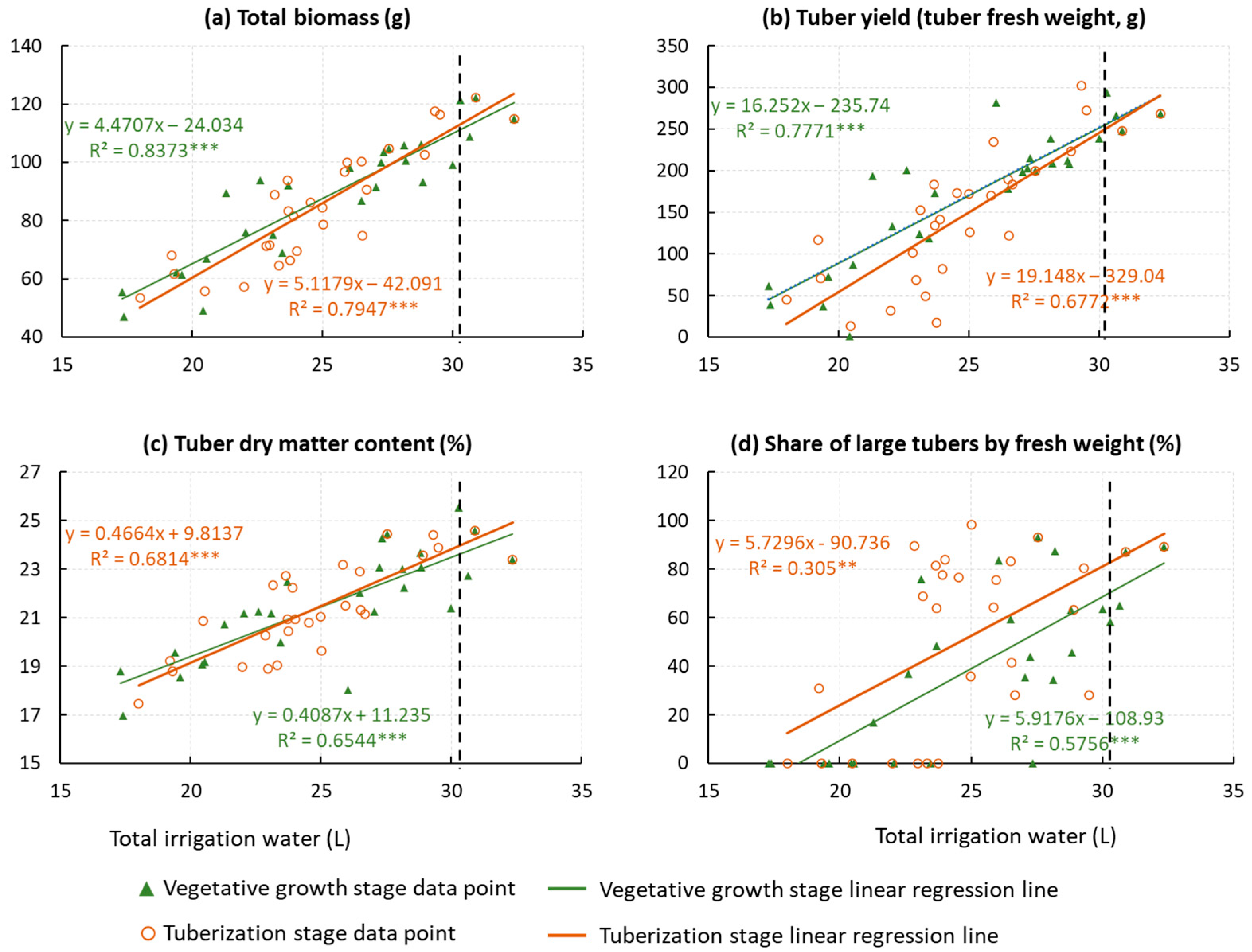Water Deficit Duration Affects Potato Plant Growth, Yield and Tuber Quality
Abstract
:1. Introduction
2. Materials and Methods
2.1. Experimental Design
2.2. Experimental Conditions
2.3. Data Collection
2.4. Statistical Analyses
3. Results
3.1. Soil Volumetric Water Content and Irrigation Water Usage
3.2. Plant Growth
3.3. Plant Biomass
3.4. Tuber Characteristics
3.5. The Effects of Total Volume of Irrigation Water
4. Discussion
4.1. The Common Effects and Differences between VS and TS
4.2. Implications for Supplement Irrigation Practices in Humid Climate Region
4.3. Future Studies
5. Conclusions
Supplementary Materials
Author Contributions
Funding
Institutional Review Board Statement
Data Availability Statement
Acknowledgments
Conflicts of Interest
Nomenclature
| AWC | Plant available water capacity (%) |
| D2F | Days to flowering (day) |
| DAP | Days after planting (day) |
| CIWV | Cumulative Irrigation Water Volume (L) |
| DIWV | Daily Irrigation Water Volume (mL) |
| DWR | Roots dry weight (g) |
| DWT | Tuber dry weight (g) |
| DWV | Vegetation dry weight (g) |
| FC | Field capacity (%) |
| H40 | 40-day plant height (cm) |
| H54 | 54-day plant height (cm) |
| H70 | 70-day plant height (cm) |
| IWUE | Irrigation water use efficiency (g L−1) |
| LTn | Share of large tubers (>35 mm) by fresh weight (%) |
| LTw | Share of large tubers (>35 mm) by tuber number (%) |
| PGS | Potato growth stage |
| PWP | Permanent wilting point (%) |
| SC | Stomatal conductance (mmol m−2 s−1) |
| SPAD | SPAD meter reading |
| ST | Soil Temperature (°C) |
| SVWC | Soil volumetric water content (%) |
| TBM | Total biomass (g) |
| TDMC | Tuber dry matter content (%) |
| TVIW | Total volume of irrigation water (L) |
| SVIW | Volume of irrigation water during the growth stage of interest (L) |
| TS | Tuberization stage |
| VS | Vegetative growth stage |
| WDD | Water deficit duration (day) |
| Y | Potato yield (tuber fresh weight) (g) |
References
- DeMerchant, E.B. From Humble Beginnings: A Story of Agriculture in New Brunswick; New Brunswick Agriculture and Rural Development: Fredericton, NB, Canada, 1983. [Google Scholar]
- Marra, M.C.; Kezis, A.S.; Goltz, S.M.; Hedstrom, W.E.; Hews, R.D. The economic implications of potato response to irrigation: Results from 1985 field tests in Maine. Am. Potato J. 1987, 64, 249–260. [Google Scholar] [CrossRef]
- Nasir, M.W.; Toth, Z. Effect of Drought Stress on Potato Production: A Review. Agronomy 2022, 12, 635. [Google Scholar] [CrossRef]
- Lemmen, D.S.; Warren, F.J. (Eds.) Climate Change Impacts and Adaptation: A Canadian Perspective; Natural Resources Canada: Ottawa, ON, Canada, 2004; 174p. [Google Scholar]
- Marra, M.C.; Woods, T.A. B832: The Profitability of Supplemental Irrigation for Maine Potatoes; Bulletin 832; Main Agricultural Experiment Station; University of Maine: Orono, ME, USA, 1990; 37p. [Google Scholar]
- King, B.A.; Stark, J.C. Irrigation management. In Potato Production Systems: A Com-Prehensive Guide for Potato Production; Stark, J.C., Love, S.L., Eds.; University of Idaho Agricultural Communications: Moscow, ID, USA, 2003; pp. 285–307. [Google Scholar]
- Bélanger, G.; Walsh, J.R.; Richards, J.E.; Milburn, P.H.; Ziadi, N. Yield response of two potato cultivars to supplemental irrigation and N fertilization in New Brunswick. Am. J. Potato Res. 2000, 77, 11–21. [Google Scholar] [CrossRef]
- Bélanger, G.; Walsh, J.R.; Richards, J.E.; Milburn, P.H.; Ziadi, N. Nitrogen fertilization and irrigation affects tuber characteristics of two potato cultivars. Am. J. Potato Res. 2002, 79, 269–279. [Google Scholar] [CrossRef]
- De Lis, B.R.; Ponce, I.; Tizio, R. Studies on water requirement of horticultural crops. Influence of drought at different growth stages on the tubers yield. Agron. J. 1964, 56, 377–381. [Google Scholar] [CrossRef]
- Aliche, E.B.; Oortwijna, M.; Theeuwena, T.P.J.M.; Bachema, C.W.B.; Vissera, R.G.F.; van der Lindena, C.G. Drought response in field grown potatoes and the interactions between canopy growth and yield. Agric. Water Manag. 2018, 206, 20–30. [Google Scholar] [CrossRef]
- Wang, Y.; Liu, X.; Ren, G.; Yang, G.; Feng, Y. Analysis of the spatiotemporal variability of droughts and the effects of drought on potato production in northern China. Agric. For. Meteorol. 2019, 264, 334–342. [Google Scholar] [CrossRef]
- Wagg, C.; Hann, C.; Kupriyanovich, Y.; Li, S. Timing of short period water stress determines potato plant growth, yield and tuber quality. Agric. Water Manag. 2021, 247, 106731. [Google Scholar] [CrossRef]
- Foti, S.; Mauromicale, G.; Ierna, A. Influence of irrigation levels on growth and yield of potato cv. Spunta. Potato Res. 1995, 38, 307–318. [Google Scholar] [CrossRef]
- Karafyllidis, D.I.; Stavropoulos, N.; Georgakis, D. The effect of water stress on the yielding capacity of potato crops and subsequent performance of seed tubers. Potato Res. 1996, 39, 153–163. [Google Scholar] [CrossRef]
- Kashyap, P.S.; Panda, R.K. Effect of irrigation scheduling on potato crop parameters under water stressed conditions. Agric. Water Manag. 2003, 59, 49–66. [Google Scholar] [CrossRef]
- El-Abedin, Z.T.K.; Mattar, M.A.; Alazba, A.A.; Al-Ghobari, H.M. Comparative effects of two water-saving irrigation techniques on soil water status, yield, and water use efficiency in potato. Sci. Hortic. 2017, 225, 525–532. [Google Scholar] [CrossRef]
- Jensen, C.R.; Battilani, A.; Plauborg, F.; Psarras, G.; Chartzoulakis, K.; Janowiak, F.; Stikic, R.; Jovanovic, Z.; Li, G.; Qi, X.; et al. Deficit irrigation based on water deficit tolerance and root signalling in potatoes and tomatoes. Agric. Water Manag. 2010, 98, 403–413. [Google Scholar] [CrossRef]
- Teixeira, J.; Pereira, S. High salinity and drought act on an organ-dependent manner on potato glutamine synthetase expression and accumulation. Environ. Exp. Bot. 2007, 60, 121–126. [Google Scholar] [CrossRef]
- Djaman, K.; Irmak, S.; Koudahe, K.; Allen, S. Irrigation Management in Potato (Solanum tuberosum L.) Production: A Review. Sustainability 2021, 13, 1504. [Google Scholar] [CrossRef]
- Moorby, J.; Munns, R.; Walcott, J. Effect of water deficit on photosynthesis and tuber metabolism in potatoes. Aust. J. Plant Physiol. 1975, 2, 323–333. [Google Scholar] [CrossRef]
- Benoit, G.R.; Grant, W.J. Plant water deficit effects on Aroostook County potato yields over 30 years. Am. Potato J. 1980, 57, 585–594. [Google Scholar] [CrossRef]
- Rolando, J.L.; Ramírez, D.A.; Yactayo, W.; Monneveux, P.; Quiroz, R. Leaf Greenness as a Drought Tolerance Related Trait in Potato (Solanum tuberosum L.). Environ. Exp. Bot. 2015, 110, 27–35. [Google Scholar] [CrossRef]
- Cavagnaro, J.B.; de Lis, B.R.; Tizio, R.M. Drought hardening of the potato plant as an after-effect of soil drought conditions at planting. Potato Res. 1971, 14, 181–192. [Google Scholar] [CrossRef]
- Thomas, J.C.; Brown, K.W.; Jordan, W.R. Stomatal response to leaf water potential as affected by preconditioning water stress in the field. Agron. J. 1976, 68, 706–708. [Google Scholar] [CrossRef]
- Banik, P.; Zeng, W.; Tai, H.; Bizimungu, B.; Tanino, K. Effects of drought acclimation on drought stress resistance in potato (Solanum tuberosum L.). genotypes. Environ. Exp. Bot. 2016, 126, 76–89. [Google Scholar] [CrossRef]
- Zhang, S.; Xu, X.; Sun, Y.; Zhang, J.; Li, C. Influence of drought hardening on the resistance physiology of potato seedlings under drought stress. J. Integr. Agric. 2018, 17, 336–347. [Google Scholar] [CrossRef]
- Li, S. Landscape Integrated Soil and Water Conservation (LISWC) System for Sloping Landscapes in Atlantic Canada. Agriculture 2021, 11, 427. [Google Scholar] [CrossRef]
- Agriculture and Agri-Food Canada (AAFC). Potato Market Information Review 2018–2019. AAFC No. 13006E. 2019. Available online: www.agr.gc.ca/horticulture_e (accessed on 18 September 2023).
- Stocker, T.F.; Qin, D.; Plattner, G.K.; Alexander, L.V.; Allen, S.K.; Bindoff, N.L.; Bréon, F.M.; Church, J.A.; Cubasch, U.; Emori, S.; et al. Technical Summary. In Climate Change 2013: The Physical Science Basis. Contribution of Working Group I to the Fifth Assessment Report of the Intergovernmental Panel on Climate Change; Cambridge University Press: Cambridge, UK; New York, NY, USA, 2013. [Google Scholar]
- Van Loon, C.D. The effect of water stress on potato growth, development, and yield. Am. Potato J. 1981, 58, 51–69. [Google Scholar] [CrossRef]
- Lahlou, O.; Ledent, J.-F. Root mass and depth, stolons and roots formed on stolons in four cultivars of potato underwater stress. Eur. J. Agron. 2005, 22, 159–173. [Google Scholar] [CrossRef]
- Schittenhelm, S.; Sourell, H.; Löpmeier, F.-J. Drought resistance of potato cultivars with contrasting canopy architecture. Eur. J. Agron. 2006, 24, 193–202. [Google Scholar] [CrossRef]
- Milburn, P.; Gartley, C. Subsurface drainage and land use in New Brunswick. Can. Agric. Eng. 1988, 30, 13–17. [Google Scholar]




| Factor | Vegetative Stage | Tuberization Stage | |||||
|---|---|---|---|---|---|---|---|
| Slope | Intercept | R2 | Slope | Intercept | R2 | ||
| H40 | 40-day plant height (cm) | −1.65 | 55.9 | 0.75 *** | −0.83 | 45.7 | 0.50 *** |
| H54 | 54-day plant height (cm) | −0.64 | 70.8 | 0.34 *** | −0.75 | 65.5 | 0.57 *** |
| H70 | 70-day plant height (cm) | 0.02 | 75.7 | 0.00 | −0.20 | 73.5 | 0.07 |
| D2F | Days to flowering (day) | 0.45 | 45.3 | 0.38 *** | 0.36 | 46.2 | 0.35 *** |
| SC | Stomatal conductance (mmol m−2 s−1) | −9.39 | 261.5 | 0.61 *** | −0.66 | 138.2 | 0.01 |
| SPAD | SPAD meter reading | 0.63 | 43.7 | 0.79 *** | 0.05 | 44.4 | 0.04 |
| DWV | Vegetation dry weight (g) | −0.20 | 46.2 | 0.15 * | −0.10 | 46.6 | 0.03 |
| DWR | Roots dry weight (g) | −0.06 | 7.0 | 0.25 * | 0.00 | 6.9 | 0.00 |
| TBM | Total biomass (g) | −2.41 | 118.0 | 0.76 *** | −2.15 | 109.8 | 0.76 *** |
| Y | Potato yield (tuber fresh weight, g) | −8.77 | 280.0 | 0.74 *** | −8.11 | 240.2 | 0.66 *** |
| DWT | Tuber dry weight (g) | −2.15 | 64.7 | 0.75 *** | −2.05 | 56.3 | 0.69 *** |
| TDMC | Tuber dry matter content (%) | −0.20 | 23.9 | 0.51 *** | −0.20 | 23.7 | 0.67 *** |
| LTn | Share of large tubers (>35 mm) by tuber number (%) | −2.04 | 45.2 | 0.65 *** | −1.70 | 44.9 | 0.41 *** |
| LTw | Share of large tubers (>35 mm) by fresh weight (%) | −3.59 | 83.1 | 0.72 *** | −3.03 | 86.6 | 0.46 *** |
| SVWC | Soil volumetric water content (%) | −0.36 | 21.4 | 0.95 *** | −0.41 | 22.2 | 0.97 *** |
| SVIW | Volume of irrigation water during the growth stage of interest (L) | −0.35 | 9.4 | 0.90 *** | −0.31 | 12.9 | 0.84 *** |
| ST | Soil temperature (°C) | 0.02 | 20.1 | 0.14 | −0.01 | 20.5 | 0.05 |
Disclaimer/Publisher’s Note: The statements, opinions and data contained in all publications are solely those of the individual author(s) and contributor(s) and not of MDPI and/or the editor(s). MDPI and/or the editor(s) disclaim responsibility for any injury to people or property resulting from any ideas, methods, instructions or products referred to in the content. |
© 2023 by the authors. Licensee MDPI, Basel, Switzerland. This article is an open access article distributed under the terms and conditions of the Creative Commons Attribution (CC BY) license (https://creativecommons.org/licenses/by/4.0/).
Share and Cite
Li, S.; Kupriyanovich, Y.; Wagg, C.; Zheng, F.; Hann, S. Water Deficit Duration Affects Potato Plant Growth, Yield and Tuber Quality. Agriculture 2023, 13, 2007. https://doi.org/10.3390/agriculture13102007
Li S, Kupriyanovich Y, Wagg C, Zheng F, Hann S. Water Deficit Duration Affects Potato Plant Growth, Yield and Tuber Quality. Agriculture. 2023; 13(10):2007. https://doi.org/10.3390/agriculture13102007
Chicago/Turabian StyleLi, Sheng, Yulia Kupriyanovich, Cameron Wagg, Fangzhou Zheng, and Sheldon Hann. 2023. "Water Deficit Duration Affects Potato Plant Growth, Yield and Tuber Quality" Agriculture 13, no. 10: 2007. https://doi.org/10.3390/agriculture13102007
APA StyleLi, S., Kupriyanovich, Y., Wagg, C., Zheng, F., & Hann, S. (2023). Water Deficit Duration Affects Potato Plant Growth, Yield and Tuber Quality. Agriculture, 13(10), 2007. https://doi.org/10.3390/agriculture13102007






